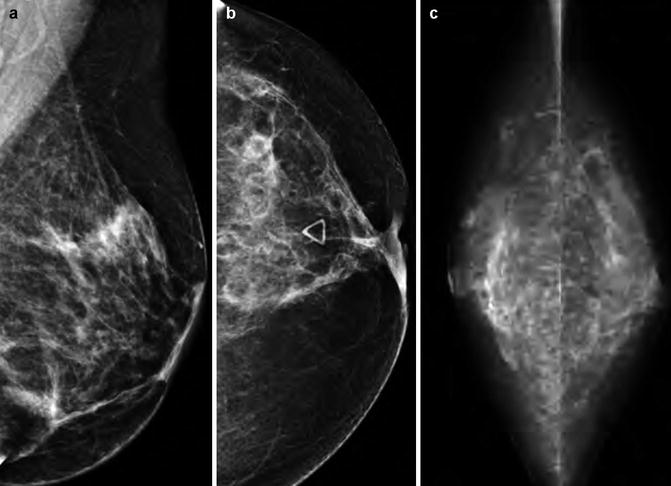Lipoaugmentation patients
Breast reduction patients
Patients, n
27
23
Age, year (mean ± SD)
35.9 ± 9.9
50.0 ± 8.9
Right breast volume change, mean ± SD
267.2 ± 36.1 cc injected
943.7 ± 905.1 g removed
Left breast volume change, mean ± SD
260.0 ± 53.8 cc injected
820.0 ± 806.3 g removed
Table 41.2
Rates of radiologic findings across all readings
Breast reduction (n = 184) | Lipoaugmentation (n = 216) | P | |
|---|---|---|---|
Oil cysts | 58 (31.5 %) | 55 (25.5 %) | 0.18 |
Scarring | 158 (85.6 %) | 38 (17.6 %) | <0.001 |
Calcifications, benign/fat necrosis | 50 (27.2 %) | 37 (17.1 %) | 0.02 |
Calcifications warranting biopsy | 3 (1.6 %) | 10 (4.6 %) | 0.16 |
Mass or distortion warranting biopsy | 25 (13.6 %) | 6 (2.8 %) | <0.001 |
Table 41.3
Breast imaging reporting and data system score across readings
BI-RADS Score | 1 | 2 | 3 | 4 | 5 |
|---|---|---|---|---|---|
Breast reduction | 9 (4.9 %) | 130 (70.7 %) | 19 (10.3 %) | 26 (14.1 %) | 0 (0.0 %) |
Lipoaugmentation | 78 (36.1 %) | 114 (52.8 %) | 10 (4.6 %) | 14 (6.5 %) | 0 (0.0 %) |
Table 41.4
Radiologist follow-up recommendations
12-month follow up | 6-month follow up | Biopsy | |
|---|---|---|---|
Breast reduction | 76 (41.3 %) | 80 (43.5 %) | 28 (15.2 %) |
Lipoaugmentation | 11 (5.1 %) | 191 (88.4 %) | 14 (6.5 %) |

Fig. 41.1
(a) A breast reduction scar on mammography image. (b) Fat necrosis and formation of oil cyst secondary to breast reduction procedure. (c) A mammogram from lipoaugmentation with evidence of oil cyst formation
The evidence supporting the practice of fat grafting in the breast suggests that cancer screening can be effectively performed.
41.6 Conclusions
Despite controversy concerning cancer detection, current evidence supports the concept that effective screening can be preformed.
41.7 Future Direction
The promising potential of adipose-derived stem cells (ADSCs) harvested during liposuction is an area of great interest. The potential clinical utility of these cells in the treatment of patients who present with a breast deformity after segmental mastectomy (lumpectomy) and radiation therapy has been described, but not studied in a rigorous, prospective manner. The challenge at hand is to collect well-controlled data.
References
1.
Neuber F. Fat transplantation. Chir Kongr Verhandl Deutsch Gesellsch Chir. 1893;22:66.
2.
Czerny M. Reconstruction of the breast with a lipoma. Chir Kongr Besh. 1895;2:216.
3.
Lexer E. Free fat grafting. Dtsch Med Wochenschr. 1910;36:640.
4.
5.
Report on autologous fat transplantation. ASPRS Ad-Hoc Committee on New Procedures, September 30, 1987. Plast Surg Nurs. 1987;7:140.
7.
8.
9.
10.
11.
14.
Coleman 3rd WP. The history of liposuction and fat transplantation in America. Dermatol Clin. 1999;17:723.PubMed
15.
Burnouf M, Buffet M, Schwarzinger M, Roman P, Bui P, Prevot M, Deleuze J, Morini JP, Franck N, Gorin I, Dupin N. Evaluation of Coleman lipostructure for treatment of facial lipoatrophy in patients with human immunodeficiency virus and parameters associated with the efficiency of this technique. Arch Dermatol. 2005;141(10):1220–4.PubMedCrossRef
16.
17.
Coleman SR, Saboeiro AP. Fat grafting to the breast revisited: Safety and efficacy. Plast Reconstr Surg. 2007;119(3):775–85.PubMed




Stay updated, free articles. Join our Telegram channel

Full access? Get Clinical Tree








